The rat
We were sitting in a neighborhood café when I saw her. Someone had lost interest in their lunch, and had dumped a plate half-full of food onto the top of the gray plastic tub where the used coffee cups go. She was sitting nearby, nibbling at a piece of pita bread she had grabbed from the plate, her whiskers glinting in the afternoon sunlight.
I sipped my iced coffee and watched. After a few seconds she vanished from sight, but I waited patiently, and less than a minute had passed before she reappeared, her head popping up over the rim of the tub of dishes. She sniffed at the plate of discarded food, grabbed another tasty morsel in her mouth, and disappeared again.
I wasn’t really sure what to do. We were outside, but still, I was fairly sure the café would not be pleased by her presence. I decided I ought to let them know that there was a — a what, exactly? She looked like a large mouse, right down to the ears. Was she a Texas-sized mouse? The squirrels here get pretty large, so I wondered if it was the same with other rodents. She looked too small to be a rat. A young rat, perhaps? Yet her foraging looked like a mother taking food back to her young.
In the end I decided to hedge my bets. As we left I told the staff there was a small rat, or possibly a large mouse, eating from the discarded dishes.
Back at home, I turned to the Internet for taxonomic assistance. I learned the source of my confusion. I was familiar with pet rats; fancy rats. Those are bred from rattus norvegicus, the Norway Rat, one of the largest of all rat species. Norway Rats are the ones you know from documentaries, horror movies, and Winston Smith’s nightmares. Sewer rat, wharf rat, street rat, they’re all aliases of the versatile Norway rat. They live in every human-populated area. If you live in a city, then statistically you’re probably less than 50 meters from a rat right at this moment.
Austin is home to rattus rattus, a smaller rat variety known as the Roof Rat for its habit of nesting in people’s attic spaces. Roof rats are a gentler breed, and basically look like big mice, but with longer tails. They go by the names ship rat, house rat, and old English rat. Whereas their bigger more aggressive cousins live in burrows, the roof rat prefers to live in wooden structures — trees, thatched roofs, or thickets of bamboo. They look, dare I say it, cuter.
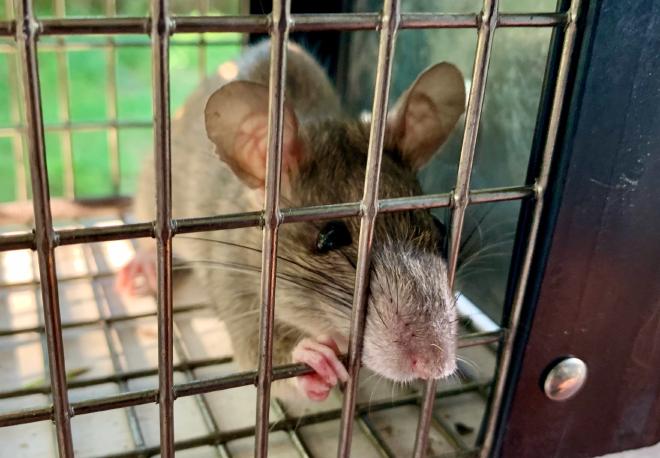
Our part of Austin is almost forest-like in places, and also full of bamboo. So is the bottom of our backyard…
I had pet rodents as a child. My first pet was a white mouse. I named her Squeak. I learned how to tell the sex of most rodents: The females have a rounder rump, whereas the males tend to be pointed in shape at the back, with a bulge underneath that can sometimes be disturbingly large.
My mother was not particularly enthusiastic about my pet mouse. Like my grandmother, she had the classic fear or disgust of mice that TV sitcoms had taught me to expect from women. One time a wild mouse got into the house and my mother climbed onto the kitchen table. I thought it was hilarious.
After my pet mouse died — they only live a couple of years — I got a hamster instead. My grandmother had identified the tail as the particularly repellent part of the mouse, so a hamster seemed like a good compromise. As well as being almost tailless, hamsters are much more mellow. They saunter around, rather than rocketing from place to place and startling parents.
At school we had class pets, a pair of gerbils who would shred any paper or cardboard offered to them, with an enthusiasm I found particularly entertaining. Like hamsters, wild gerbils are desert-dwellers. Unlike hamsters, they have long tails and can run incredibly quickly if they escape, so all my attempts to interest my family in upgrading to gerbils met with failure.
I never had a pet rat, but I knew other people who did. So I grew up viewing them as giant mice, or perhaps hamsters with tails. Cute fuzzy friendly critters.
Mankind has lived with rats for centuries, so our language is full of rats.
I smell a rat. You ratfink. Don’t rat on me. We’re all part of the rat race. Why, you dirty rat. It’s like rats leaving a sinking ship. I don’t give a rat’s ass. You rat bastard.
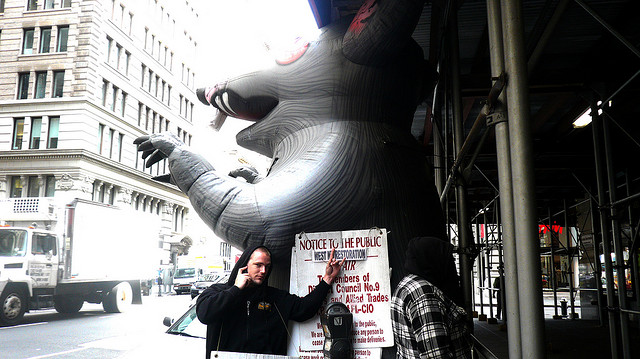
Radio Shack is sometimes dismissively referred to as “rat shack”. Frank Sinatra and his pals were known as the Rat Pack. We have mall rats and rug rats. Pigeons are described as sky rats or rats with wings. Squirrels get called tree rats. (As one man said to me when he saw me buying food for them, “They’re just rats with fluffy tails.”)
In England, we even have the insult “ratbag”, a term whose origins seem to be uncertain and possibly Australian.
Some of the negative associations with rats make sense. Historically, rats were excellent disease vectors, most famously helping to spread bubonic plague — though in the rats’ defense, it was the fleas infesting the rats which actually carried the plague. Still, rat bite fever is no fun, and nor are salmonella infections or hemorrhagic fever.
So as we grow up, we generally absorb the knowledge that a rat is a contemptible thing. There was even a minor kerfuffle when a Republican political ad used motion graphics with animated typography that emphasized the letters R, A and T at the end of “Democrat”; some people with overactive imaginations thought that this was an attempt at subliminal programming.
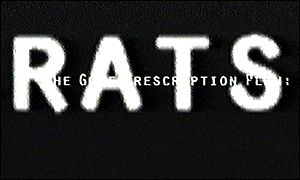
All the cultural conditioning somehow didn’t work on me. I still see rats as cute. So when I first saw the rat which I came to think of as our rat, I wasn’t immediately horrified.
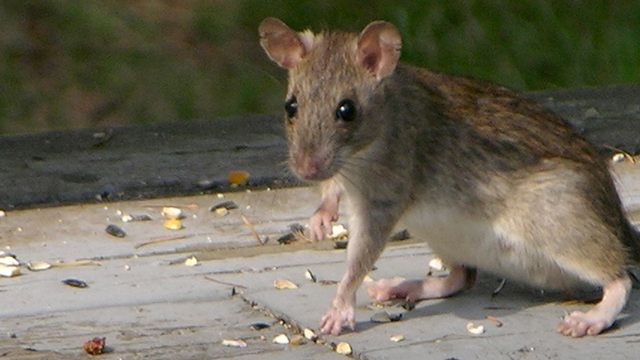
He was sitting on our back deck, nibbling at some discarded bird seed. Our parakeets are picky eaters, and I had taken to tossing out the food they threw on the floor, for the outdoor birds to pick over. We’d had fox squirrels chowing on it, and now I realized we had progressed from tree rats to actual rat rats.
Speaking of squirrels, the fox squirrel has the scientific name sciurus niger, literally “black squirrel”, simply because the scientist who picked the name happened to see a black one first. I assume there’s a similar explanation for why rattus norvegicus is known as the Brown Rat and rattus rattus as the Black Rat, because both can be either color. Our “black” rat was a beautiful chestnut brown in color, with a glossy coat and a lightly furred brown tail. He raised himself up on his pink paws, revealing a light brown belly, and looked at me with beady black eyes.
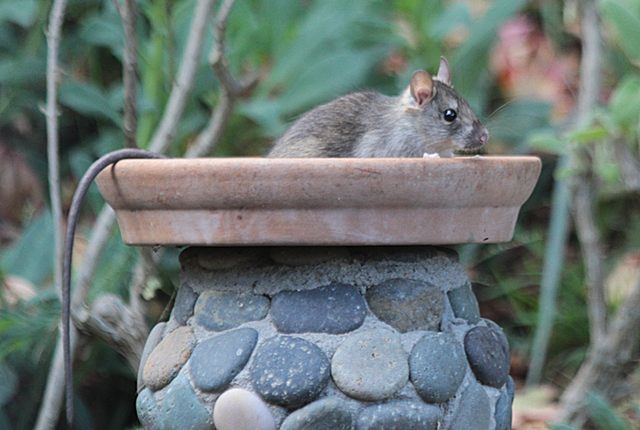
I opened the door. Maybe he could smell that I wasn’t a predator, because he stood his ground. We stood evaluating each other for a few moments. I had been expecting him to run off, so I hadn’t really planned my next move. Finally, I settled on saying “Hey!” and walking towards him, at which point he shot off in the direction of the wooden fence between our house and our neighbor’s. The lower horizontal beams of the fence made an excellent ratway, and he scurried down it and disappeared into the bamboo at the far end of the yard.
The next evening I saw him again, sniffing around to see if there was anything to eat. There wasn’t, and he ran off when I opened the door. But clearly at this point we had a rat, and it was time to consider possible consequences.
A lot of people hate squirrels, and some have problems with squirrels in the attic. We have a squirrel living in the tree right outside our house, and since they’re territorial, he generally keeps any others from investigating our house with a beady eye to moving in. Rats, on the other hand, like to breed like… well, like rats. A lone male roof rat wasn’t a problem, but if he met a female roof rat and they decided to raise a nest of ratlets, things could get expensive. As well as nesting in attics, roof rat families often like to practice their chewing on cables and ductwork. In Texas, you don’t get between a man and his air conditioning. The rat was going to have to go.
Since the Middle Ages, man has dreamed of developing effective rodent removal technologies. Build a better mousetrap, the saying goes, and the world will beat a path to your door. I assume the same is true of rat traps.
The story of the Pied Piper of Hamelin didn’t include rats originally. Historians believe that it was inspired by some tragedy which befell the children of the town, and that the rats were added to the tale later on to turn it into a morality play. The scientific accuracy isn’t much better; as far as I know, woodwind instruments are ineffective against modern rodents. However, the idea of removing rats by acoustic means continues to appeal to people, and companies sell ultrasonic devices which claim to repel rats. Unlike the completely ineffective ultrasonic mosquito repellers, there’s some evidence that the rat repellers repel rats, at least somewhat. Rats dislike being blasted with ultrasound, and will tend to move away from it unless they have a compelling reason not to. Unfortunately if there’s food around, or a nice place to raise a rat family, that’s likely to be compelling enough to make them learn to live with the noise. Online reviews suggested to me that electronic ultrasonic rat repellers weren’t even worth looking at for my problem.
In the 20th century, a popular option was rat poison. Until recently, there were rat poisons available based on anticoagulants. These work by the horrific method of causing the rat’s blood to thin until it suffers a minor injury and bleeds to death, or dies from internal hemorrhaging. However, scientists discovered that because anticoagulant poisons take a while to kill the rat, they were making their way up the food chain and being detected in bobcats, coyotes, cougars, owls, and other predators, many of which are endangered. As of this year, the makers of anticoagulant poisons have agreed to stop manufacturing them.
That leaves one commercial consumer rat poison: a chemical called bromethalin, which also goes by the snappy systematic name N-Methyl-2,4-dinitro-6-(trifluoromethyl)-N-(2′,4′,6′-tribromophenyl)aniline. It’s a nervous system toxin with no known cure, which makes it a bad thing to leave around where any creature you like might find it, such as squirrels, dogs, cats, or children. Since our back deck is visited by friendly squirrels and birds, I didn’t want to put poison out. In fact, I didn’t want to kill the rat at all, I really just wanted him to live somewhere else.
Most people prefer to kill their rats, of course. I mentioned mousetraps earlier, and a larger version of the classic snap-shut mousetrap can also be used to catch rats. If you absolutely have to trap and kill your rats, the snap trap is probably your best option. The animal dies almost instantly. It’s grisly to clean up, but it’s cheap and effective.
The most horrific traps by far are glue traps. The rodent’s fur or limbs tend to get stuck to the glue, and it pulls at them frantically, generally getting itself even more stuck. If you’re checking on the traps regularly, you can mess with oil or cornstarch to release the trapped rodent into a bucket, then humanely euthanize it somehow or release it somewhere — but let’s face it, most people who use glue traps leave the animal to die in the trap. It’s a lingering death by starvation and dehydration, and terrifying for the victim. Even if you release the creature, it’ll be suffering all the time it’s in the trap. Sometimes rats will gnaw through their own limbs in order to try to escape. If you use glue traps, you are a horrible person.
Back in the Victorian era, the rat-catcher often hunted rats using trained terrier dogs. However, we don’t have space for a dog in our life, and I’m allergic to cats, so those two methods of natural pest control were out. Rat-catchers also used cage-style traps, and it was cage traps that I found myself gravitating towards. I’d catch the rat, take him somewhere, and release him. Simple! In the meantime he’d be able to sit in the cage and chow down. He wouldn’t be happy, but he wouldn’t be in a state of terror or suffering.
I’d had some experience with a trap before, back when I was trying to catch an injured squirrel. That time, I had bought a cheap trap from Harbor Freight Tools. It had proved completely and utterly useless. I decided this time I’d go for a higher quality, brand name trap. The leading brand in the US is Havahart.
Havahart traps are neat and well-made. Once the trap is set, pressure on a plate inside the trap makes the door spring shut and clip closed. You can then pick up the whole thing by the handle on top, take it to the release point, and unclip and open the door to release whatever you caught.
I tried local stores. They had the larger Havahart traps for raccoons, squirrels, Norway rats, and other larger rodents, but reviews suggested that those were problematic for roof rats. Being on the small side, roof rats often fail to put enough pressure on the activation plate to set off a large trap. So I went online and ordered the smallest Havahart trap, model 0745, the one for chipmunks, squirrels, and rats.
I set the trap out on the back deck the evening it was delivered. I baited it with bird seed from the bottom of the parakeet cage, as I knew our rat liked that. I sat at a table where I could see out of the back windows, and within half an hour, I saw the rat wander into view. Unfortunately, he looked around and spotted me, and decided that maybe this time discretion was called for. He didn’t come back during daylight hours, so I left the trap in place that night when I went to bed.
I woke up around 2 a.m. and found myself wondering if I had caught anything in the trap yet. I went downstairs and shone a flashlight out the window — and there in the trap was my little rat friend! He blinked in the light, and started chewing on the cage bars in a desperate attempt to escape.
I turned the flashlight off. I had expected it to take a few attempts to entice him into the trap, perhaps 2–3 nights. Instead, it had taken a few hours. It seemed too good to be true. I turned the flashlight on and looked again, but no, I hadn’t imagined it. There was definitely a rat in the trap, and he looked like the rat I had seen earlier in the day.
At this point I realized I hadn’t really made any definite plans for what to do next, beyond deciding that I’d drive somewhere and release him. I started looking for helpful advice on the Internet.
The first page I found offering helpful rat relocation advice was by PeTA. It was rather optimistically titled “Living in Harmony With Rats”. It said that I should release the rat within 100 yards of where I had caught it, because releasing it outside that area would almost certainly result in its death.
I could immediately see a couple of problems with this piece of advice, the first being that I was pretty sure a rat could find its way back home over a distance of a hundred yards.

But even if I was wrong, the area a hundred yards around our backyard contains dozens of families’ homes. The law said that to release a captured critter I had to have permission from the owner of the land. I was pretty sure that none of my neighbors would volunteer their yards as a rat habitat. Make the rat a surprise gift, and they’d probably put down poison or glue traps. So following PeTA’s advice would not be doing the rat any favors. Still, maybe my whole plan was wrong? Maybe I ought to be euthanizing the rat, rather than relocating him to some unfamiliar area to get eaten by a snake?
The next web page I browsed to supported that thought, saying the best thing to do with a live-caught rat was to euthanize it humanely. The suggested method was to use a hammer.
A hammer?

I did have a hammer; several, in fact. I had some thick gardening gloves. I…
No. Absolutely not. I’m sure there are many people in this world who can grip a squirming rodent in one hand while they smash its brains in with a hammer, but I am not one of those people. Maybe after the apocalypse when rat stew is my only hope for avoiding starvation, yes, but not until then.
Lethal injection? Not likely. The vets would all be closed at this hour of the night, and I didn’t want to leave him in the trap until morning.
Gassing? Theoretically I could get some dry ice from the supermarket (open 24 hours), put it in a bucket, put the rat in the bucket, seal up the whole arrangement, and wait for the rat to go to sleep. However, this struck me as a plan with an unacceptably high probability of catastrophic failure, specifically involving the rat leaping out of the bucket.
I decided there was no other option. I was going to have to find somewhere far away to release the rat. Maybe he’d have trouble finding food, maybe he’d get eaten, but at least he’d have a sporting chance at life. It wasn’t perfect, but it was the best I could do.
I pulled up Google Maps and scanned for suitable locations. After a few minutes I found a wilderness preservation area that was a good 10 miles outside the city. It had a small river running through it, plenty of trees, and there was a stretch of road where I could stop that looked to be a mile from any buildings, and not privately owned land.
I got dressed and went outside. It was a pleasantly warm spring night. I bent down to pick up the trap, and the rat gave me a look that seemed to suggest that he realized he had made some questionable life choices.
I put a plastic bag down in the trunk of the car, then put newspaper on top of that, then wedged the cage in place. The last thing I wanted was a permanent smell of rat urine in the car.
The drive was uneventful. I’ve read that rats sometimes scream when they’re trapped, but my rodent companion kept silent. The roads were eerily clear of other vehicles, and I started wondering what I’d say if I got randomly stopped by some bored cops. I decided I’d tell them I was suffering from some insomnia and taking a short drive to clear my head. It had the benefit of being true, which was probably advisable given that I have had no real practice at lying convincingly.
I left the outskirts of the city proper, and found myself driving down a wide unlit stretch of freeway, past dimly sodium-lit warehouses and factories. Suddenly I saw a deer in the headlights, its eyes gleaming. Luckily it wasn’t in the road, and it turned its head to watch as I sped past. Moments later I saw a second deer, or rather the body of one lying dead on the hard shoulder.
I came to a T-junction and turned. Now even the industrial buildings disappeared, and I was on an empty country road. I started to wonder if I was crazy to be out here. It felt like I was driving through the kind of place where bad things happened, where murderers dumped bodies in ditches and hitchhikers enticed victims to stop for them.
The GPS told me I was at my planned destination point, so I pulled over onto the hard shoulder, stopped the car, put the hazard lights on, and looked around. There was a halo of orange light from a freeway light, but beyond that was darkness. No lights from buildings or vehicles in any direction.
I got out of the car into the quiet night. The ground was sandy, with patches of scrub. A small low hill looked to lead to a more forested area, but I decided the rat was going to have to find his own way there. It was all starting to feel a bit too much like a scene from a Coen brothers movie, and I suddenly desperately wanted to be back at home in bed.
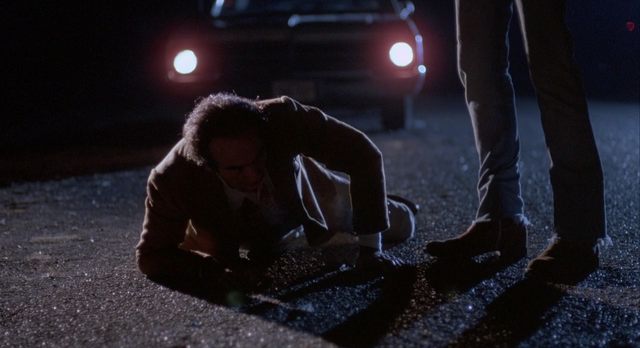
I took the rat trap out of the trunk and unclipped the door latch. I stepped a few paces from the car, bent down, held the trap near the ground, and opened the door.
Nothing happened.
I shook the trap gently. Nothing happened again. The rat might have been desperate to get out of the trap earlier on, but now that I wanted him to leave, he had apparently decided he quite liked the place. Finally, I gave the trap another shake, and his head appeared through the door opening. He sniffed the night air, jumped down onto the ground, and scurried off into a clump of grass.
I put the trap back in the trunk, got into the car, and shut the door with a profound sense of relief. Half an hour later I was back in my bed.
And there the story ends. I have no exciting coda. The rat didn’t return unexpectedly. No additional rats have shown up. As far as I know the rat is still out there somewhere. If not, hopefully he at least participated in the beauty of nature by feeding a snake or a vulture.
“Moths beat on the windowpane
Telling me I’m not the same
Sounds of nothing, sounds of fear
Speak to me when no one’s near
I’m on Rat Patrol”
— They Might Be Giants
Rat hammer ad: fancy rat photo by AlexK100; mallet photo by Mauro Cateb.